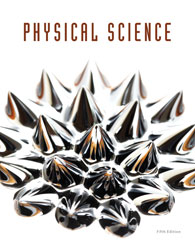BJU Press's Physical Science course is intended for use with ninth graders. This is a challenging and thorough course on a college prep level. It requires students to work with mathematical formulae and perform calculations, and it includes extensive lab work.
At the beginning of every chapter is a “dominion science” problem, a challenging, real-life situation that scientists have tried to solve. For example, the first chapter tells the story of Air France Flight 447 from Brazil that disappeared over the Atlantic Ocean. The search for the downed flight, the concern for the lost passengers, and the role of science in solving the mystery reoccur throughout the chapter as a sort of theme that leads to scientific questions and exploration.
The text begins with three chapters in the first unit that cover foundations of scientific methodology with topics such as the nature of science, worldviews in relation to science, matter, models, and measurement.
The next three units delve into the arena of physics covering topics such as mechanics, kinematics, forces, gravity, energy, energy conservation laws, work and simple machines, fluid mechanics, thermodynamics, electricity, magnetism, periodic motion and waves, sound, electromagnetic energy, light, and optics.
Units five and six shift to chemistry as they teach about atoms, elements, the Periodic Table, bonds, compounds, chemical reactions, mixtures and solutions, acids, bases, and salts.
The extensive work in both physics and chemistry means that students completing this course will have solid grounding for subsequent chemistry and physics courses in high school.
A Christian perspective is introduced frequently within the text, often as a fundamental part of the discussion. Some points regarding Christian views are brought up in the teacher’s edition for the teacher to present.
“Facets of Science” pages scattered throughout the text highlight key concepts, people, or events. These are diverse topics that either don’t readily fit into the flow of the text or deserve special attention. Facets of Science pages address topics such as the braking distance of automobiles, entropy and the Second Law of Thermodynamics, Samuel B. Morse and his invention of the telegraph, and radioactive dating methods.
The Subject Kit includes the student text, the two-volume teacher’s edition, lab manual, teacher’s edition for the lab manual, and the tests and answer key.
Lab activities are a vital component of the course. But there are three ways that you might accomplish this with supplementary lab kits. BJU Press lists a specially created Logos lab kit for this Physical Science course on their website. This Logos kit is designed to be used along with the Physical Science Lab Manual and it's teacher's edition. That manual was written for classroom situations, so the Logos lab kit includes an addendum that tells you when and how to adapt experiments for the homeschool setting. With BJU Press’s Physical Science Lab Manual students perform a good number of experiments, but they also do calculations based on simulations and learn to use a scientific calculator. The Physical Science Lab Manual incorporates the use of technology-based modeling tools that are more up-to-date than the equipment and resources used in “older” courses. One primary resource, the Vernier LabQuest probeware system, is too expensive for most homeschools. The addendum adapts activities to omit the use of probeware and make all of the experiments much more affordable and practical for homeschoolers. Using this kit will provide lab work for homeschoolers that is the most comprehensive and most tightly correlated with the textbook.
Some homeschoolers might prefer one of two options from Quality Science Labs. They have two MicroPhySci Kits: a standard edition and a standard second edition. The latter has many more experiments and is more expensive. These kits include a lab manual and answer key. They show correlations to lessons in the BJU Press text as well as to courses from other publishers. The lab activities are not tied directly to the lessons as thoroughly as with the first kit. The lab experience with these more generic kits will neither be as comprehensive nor as sophisticated as with the kit designed particularly for this course. If you use a kit from Quality Science Labs you will not need the BJU Press Physical Science Lab Manual or its teacher’s edition.









